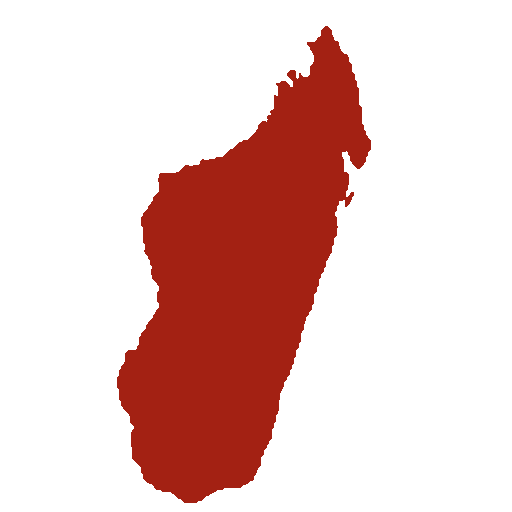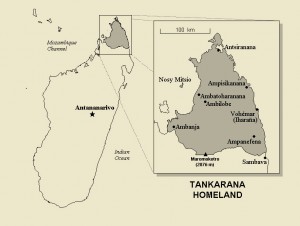The Antakarana people are one of Madagascar’s 18 tribal groups and one of the least-reached by the good news of Jesus. There are currently about 400,000 Antakarana people and they live on the northern tip of Madagascar and on some of the small surrounding islands. All Antakarana people speak the Antakarana dialect (very distinctly different from the official Malagasy language of Madagascar), and the most-educated among them also speak French and a very few speak English. It’s generally estimated that less than 2% of the Antakarana people have been reached by Christianity, and almost all of those reached are living in the cities and large towns of northern Madagascar. However, the majority of the Antakarana live in distant rural villages or small islands that are entirely unreached by the Gospel of Christ.
The name of the Antakarana tribe means “the people of the rocks“, specifically referring to the wind- and rain-carved limestone “tsingy” formations and caves in the nearby mountain range. Throughout most of Madagascar’s history, the Antakarana people have been mostly cut off from the rest of the island by the Tsaratanana mountain range on their south. However, in the early 1800s Madagascar’s most-powerful tribe, the Merina in the central highlands, expanded their kingdom over the entire island through warring with all the other tribes, including the Antakarana. During their resistance, the Antakarana fled and survived with their king for over a year in the limestone caves in northwestern Madagascar. Many Antakarana were buried in those caves during that time and the place became sacred to them, which is why they’re now known as “the people of the rocks.”
When their hiding location was found out by the Merina, the Antakarana king made a vow to the god of the neighboring Arab traders, that if they were able to successfully escape the conquering Merina, he and all of his people would become Muslim. They set off in dugout wooden canoes across the ocean and safely arrived on the small island of Nosy Mitsio, about 30-40 km from the mainland of Madagascar. The Merina never pursued them further and so the Antakarana king honored his vow to become Muslim and commanded all of his people to do the same.
To this day, most of the Antakarana people still follow the demands of their ancestors and claim allegiance to Islam. However, it’s an allegiance primarily in name (which is also true of many of the colonialist-founded Christian churches in Madagascar). There are almost as few Islamic mosques throughout Antakarana areas as there are Christian churches. Most Antakarana people simply say they’re Muslim while still worshiping their ancestors and practicing spirit possession rituals and sacrifices to their ancestors and other animistic spirits.
Antakarana people are typically very proud of their cultural and historical heritage and ethnic identity, and they often distrust input from outsiders. In particular, they maintain an animosity towards the Merina because of the past conflict and because of modern differences in language and culture. Because most of the churches in Madagascar are run by the Merina and in the official Malagasy dialect (the Merina one), that may be why the Antakarana people have been so resistant to Christianity in their area in the past.
Because of the Antakarana people’s unique historical and cultural heritage, and our desire to share the abundant life of Jesus with them in ways that will truly bring them new life, our work among them began on the island of Nosy Mitsio. We spent the previous five years (2013-2018) living in the small royal village of Ampasindava on Nosy Mitsio, learning the Antakarana language, culture, and way of life, attempting small-scale community development projects with them, and translating a Bible story set into their language. Though the people of Nosy Mitsio have continued to be resistant to the Gospel during the five years we spent with them, many good relationships were built and many seeds were sewn and we have hope that what God has taught us and done among them can be used to reach the Antakarana elsewhere on the mainland of Madagascar.
As members of YWAM Frontier Missions, we’re currently pioneering a new work to reach the Antakarana based out of Ambilobe. Ambilobe is the primary geographical center of the Antakarana people, being the place where their head king lives, it’s the principle market hub for the area, and it’s also the primary crossroads for the major towns and cities in the far north of Madagascar. We expect to grow a new ministry team in this area, made up of national Malagasy Christians and any other workers that God has called to this long-term work. We hope that from this central location, renewed efforts can be made to reach the Antakarana people through holistic community development and a disciple-making movement. The long-term goal is to see the Antakarana people worship and follow Jesus in ways that are authentic both to their cultural identity and to the new life Jesus brings to them. We then hope to see it turned into a movement, led by the Antakarana themselves, to spread Jesus’s new life throughout the rest of the Antakarana people and northern Madagascar.
On Distant Shores: Church-planting Among the Antakarana of Nosy Mitsio
Here’s an introduction to the Antakarana people and an overview of the work our ministry team did among them from 2013-2016.
Nosy Mitsio | 001
Here is a nice short introduction to the Antakarana of Nosy Mitsio and to our former ministry team.
Bound to the Past from AIM On-Field Media on Vimeo
Here is an excellent video developed by AIM, telling the story of both the Antakarana and the Sakalava (a related tribe to the Antakarana).
On a Mission to Madagascar
This is a short introduction to the country of Madagascar, to our past work in the rural villages of the east with YWAM Tamatave, and an introduction to the start of our work with the Antakarana tribe, with a little footage from Nosy Mitsio.
For further resources on the Antakarana people, please see the following:
Madmissions blog posts for Antakarana people – Sometimes personal stories and anecdotes are the best way to learn. This will take you to all the pages and blog posts on our site that we’ve written about personal experience with the Antakarana people.
The Antakarana People of Madagascar – The AIM profile of the Antakarana people, together with regularly updated prayer requests.
Antakarana Ethnic Profile – The Joshua Project ethnic profile of the Antakarana people (unfortunately the information is somewhat inaccurate and also dated)
Ethnographic Survey of the Antakarana People – An older, but fuller, ethnic profile of the Antakarana people, including prior missions efforts among them
Antakarana page on Wikipedia – a great article on the Antakarana people and their history as a people group
An Island Too Far – A vivid story written by AIM workers about the Antakarana people and visiting Nosy Mitsio (and Nosy Be) while scouting for the future work that we’ll be beginning next year
The Antakarana – An Interview – A short video interview of AIM Madagascar’s former unit leader talking about the future work among the Antakarana people on Nosy Mitsio




What an incredible story and a beautiful place! Thanks for sharing that video, too! I will be praying as always 🙂 May God give you guys favor and grace as you make this journey to these people.
-Allie